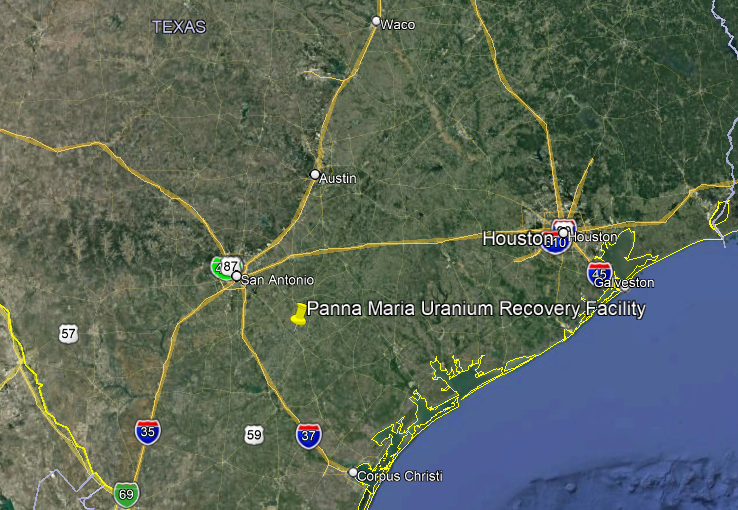Rio Grande Resources Corporation – Panna Maria
1.0 General Site Information
| Site Location: |
Hobson, TX |
| Agreement State License Number: |
R-02402 |
| Former NRC License No.: |
|
| NRC Docket No.: |
|
| Agreement State Contact: |
Hans Weger |
512-239-6465 |
| NRC Agreement State Site Monitor: |
Duncan White |
Duncan.White@nrc.gov |
| NRC Site Monitor: |
John Saxton |
John.Saxton@nrc.gov |
2.0 Site Description
The Panna Maria Uranium Recovery Facility is a former conventional mill site located in Hobson, Texas, approximately 45 miles southeast of San Antonio, Texas (Figure 1). The nearest major surface water body is the San Antonio River, which is located approximately 1 to 2 miles southwest of the now-closed facility tailings impoundment (Figure 2).

Fig. 1: Panna Maria Uranium Recovery Facility Location Map (from Google Maps)

Fig. 2: Closed Tailings Impoundment Location Map (modified from Google Earth 2019 Aerial Photography)
3.0 Site History
A radioactive material license was issued to Chevron Resources Company in September of 1977 authorizing radioactive materials for a Troxler Model 3411 moisture/density gauge. The license was subsequently amended in October of 1977 to authorize processing of uranium ore into uranium concentrate. From that license the Panna Maria mill site was developed and operated. The mill site consisted of a milling complex, with a dryer, and a tailings impoundment of approximately 160 acres adjacent to the mill complex to dispose of tailings and other waste from the milling process. The mill processed ore from conventional surface mines in Texas and ore from the Chevron Mt. Taylor mine in New Mexico. Ore from mines in Texas were transported by truck to the mill, while ore from the Mt. Taylor mine was shipped by rail to a spur near the Panna Maria mill facility. Ore was off loaded from the rail cars to trucks and transported the remaining distance to the mill site for processing.
The mill actively produced yellowcake between 1979 and 1992 at a maximum production capacity of 3000 tons of ore per day. During its operations, an estimated 6.8 million tons of ore was processed using sulfuric acid leach and solvent extraction techniques and disposed in the tailing impoundment (ML19238A194).
In addition to the by-product material and other waste from the Panna Maria Mill Site operations, the licensee was also authorized to receive processed materials containing uranium for the purpose of reprocessing for its uranium content. Additionally, the licensee was authorized to receive uranium processing waste from other uranium operations for disposal in the mill tailings pond. Authorization for processing was removed from the license in July of 1993 and replaced with an authorization for possession incidental to decommissioning and reclamation activities. Surface reclamation was performed between 1992 and 1993 with completion of the final multi-layer cover for the tailings impoundment in 2000. The closed tailings impoundment covers an area of approximately 150 acres with a maximum height of 50 feet (Figure 2). The impoundment is situated above ground and its perimeter is surrounded by and earthen dike. TCEQ estimates the impoundment contains a Radium-226 activity of 1,972 Curies, and a Thorium-230 activity of 1,972 Curies.
During its operations, the site was owned by Chevron Resources Company. In 1997, Rio Grande Resources Corporation acquired the property and is the current owner. The State of Texas, as an Agreement State, had the authority to oversee the Panna Maria license for possession, use and storage of radioactive materials. In the past, various agencies within The State of Texas government were responsible for overseeing the licensing; currently, the regulatory agency with oversight of the facility is the Texas Commission on Environmental Quality (TCEQ).
The State of Texas is seeking transfer of control (license) for the facility to DOE for long-term care and maintenance. In 2019, the TCEQ submitted a draft Completion Review Report (CRR) for the facility to the NRC for review and comment. An outstanding issue identified during that review is the selection of groundwater remedy and applicable groundwater protection standard for uranium in groundwater at the site. The NRC and TCEQ are in discussions to resolve this issue.
4.0 Current NRC actions/status
None. NRC will review CRR when completed by the State. NRC interacts regularly with the State to maintain awareness of site status.
5.0 Expected Transition to DOE for LTS&M
2024 (See DOE LM Site Management Guide, June 2022)
Page Last Reviewed/Updated Friday, October 28, 2022